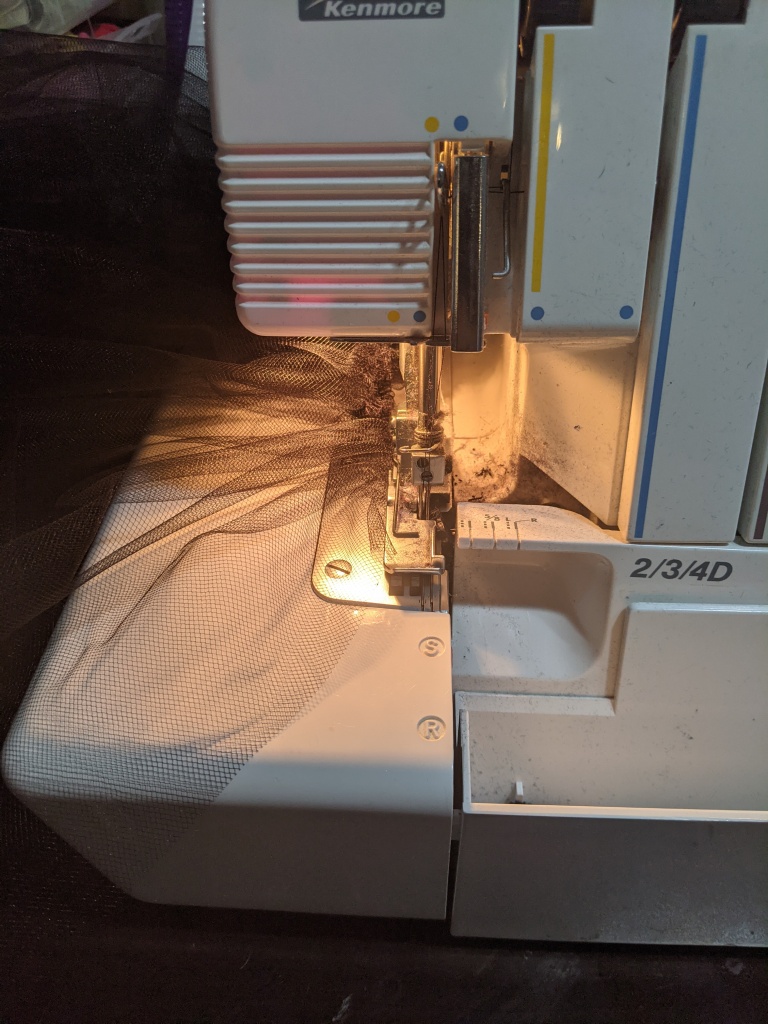As part of my homework for a Theatre History class this week, I constructed a basic romantic tutu with an emphasis on historical technique. I’ll go into further text details at a later date, but for now, here are some photos of the construction process that I opted not to upload with my assignment. For future reference, this took about five hours to complete, patterning to finish.

Adding the final layer of tulle to the basque. 
Fabric cut using my custom basque pattern. I opted to use twill over spandex, as twill would have been a more historically accurate choice. 
Finished romantic tulle skirt! 
The tutorials I used recommended quilting or zig-zag stitching a piece of stronger net over the center back to give the bars something to attach to. I opted for quilting to try something outside of my norm and hand sewed the bar side. 
Drafting the basque. This pattern is a bit different from my normal waistband approach, but it’s fascinating to see the process behind the curve creation. 
Stitching the individual layers of gathered tulle to the basque. 
Hook side of the fasteners on the wrong side of the basque. 
Sewing the base pieces of the basque. 
Gathering the tulle using my preferred method on the serger due to time constraints. 
All the tulle cut and marked for the corresponding layer on the skirt. 
Marking the basque for stitch lines.
And just for fun, here are just a few of the sources I stumbled across while working on this project:
Brockett, Oscar G., and Franklin J. Hildy. History of the Theatre. 10th ed., Pearson, 2008.
Folts, Claudia R. The Classical Tutu Book. Charlotte, Developpe Publishing, 2002, pp. 11-16.
Hamilton, Caroline. “A Brief History of Tutus, From the Romantic Era to Today.” Pointe Magazine, 22 Dec. 2020, http://www.pointemagazine.com/tutus-2649521662.html?rebelltitem=2#rebelltitem2. Accessed 31 Jan. 2021.
Halsey, Travis. “How to Create a Romantic Tutu for Professional Dancers with Travis Halsey (Part One).” YouTube, uploaded by Rachel Finzen, 7 July 2020, https://youtu.be/6nCz4fr4w4w. Accessed 31 Jan. 2021.
Looseleaf, Victoria. “The Story of the Tutu.” Dance Magazine, 2 Oct. 2007, http://www.dancemagazine.com/the-story-of-the-tutu-2306873745.html. Accessed 31 Jan. 2021.
Macaulay, Alastair. “‘Swan Lake’ Discoveries Allow for a Deeper Dive Into Its History.” The New York Times, 13 Oct. 2015, http://www.nytimes.com/2015/10/14/arts/dance/swan-lake-discoveries-allow-for-a-deeper-dive-into-its-history.html. Accessed 31 Jan. 2021.
Primary resources:
Sсherer and Nabgoltz’s Photography Studio. Portrait of Anna Sobeshchanskaya as Naiad in Cesare Pugni’s ballet “The Naiad and the Fisherman”. The Bolshoi Theatre, Google Arts and Culture, https://g.co/arts/Gwq21G4L3QAxSepE6. Accessed 31 Jan. 2021.
C. A. Fischer’s Photography Studio. “Portrait of Vera Karalli as Odette in P. Tchaikovsky’s ballet ‘Swan Lake’”. The Bolshoi Theatre, Google Arts and Culture, https://g.co/arts/VP23eKQpG2JCRU6X8. Accessed 31 Jan. 2021.
C. A. Fischer’s Photography Studio. “Portrait of Yekaterina Geltzer as Aurora in P. Tchaikovsky’s ballet ‘The Sleeping Beauty’”. The Bolshoi Theatre, Google Arts and Culture, https://g.co/arts/z5UsnEfrFEtLxjUQ7. Accessed 31 Jan. 2021.
Not used, but still interesting:
https://www.playbill.com/article/how-tschaikovskys-swan-lake-changed-ballet-forever
One thought on “The Romantic Tutu”